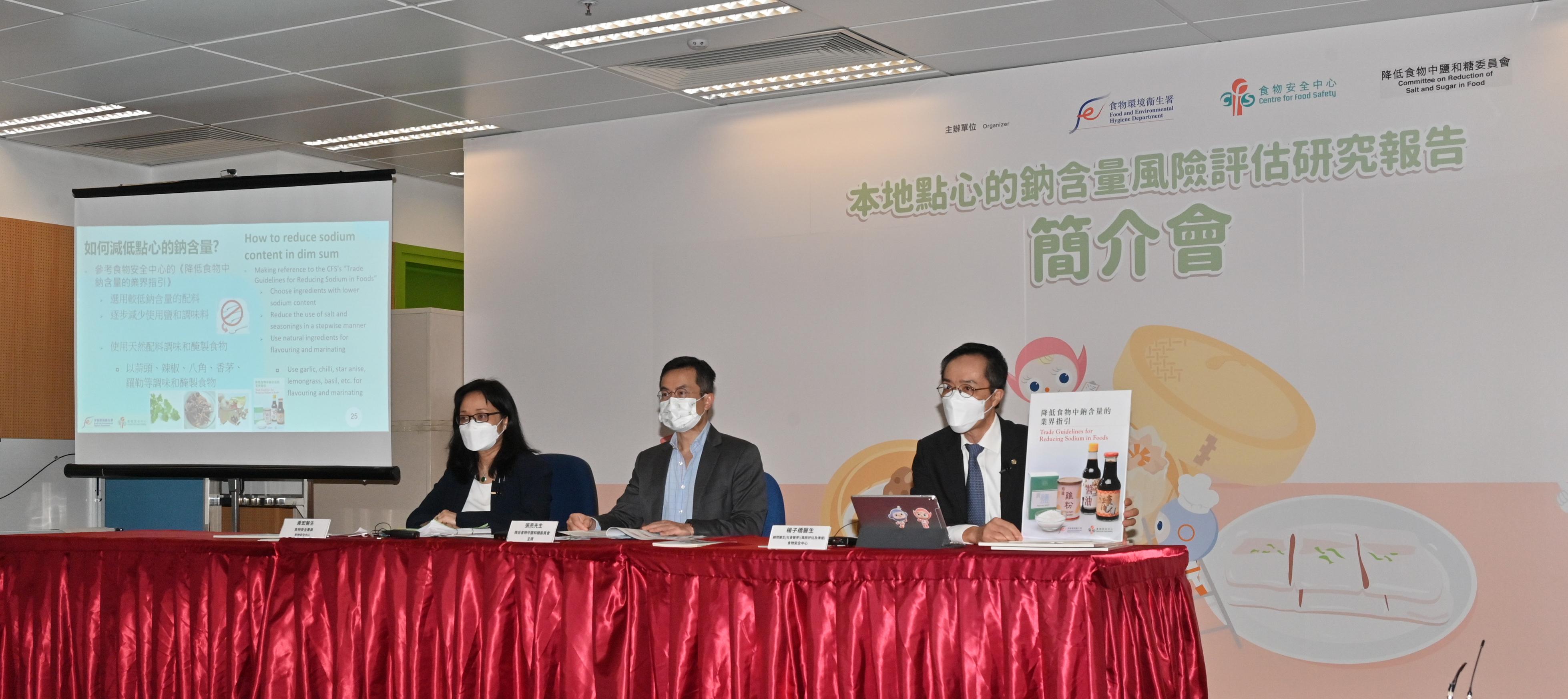CFS announces study results on sodium content in dim sum (with photos)
The Centre for Food Safety (CFS) of the Food and Environmental Hygiene Department today (July 12) released the study results on the sodium content in dim sum, which showed that there was a decreasing trend in the sodium content of dim sum when compared to the previous study results. The sodium content of certain types of dim sum, such as shrimp siu mai, spring roll with shrimp and steamed minced beef ball, was relatively higher. In addition, there was a wide variation in sodium content among samples of the same types of certain dim sum, which revealed the possibility for the trade to reduce the sodium content in these types of dim sum.
A total of 120 non-prepackaged food samples covering 12 types of dim sum, together with samples of four types of sauces, were collected from various Chinese restaurants and dim sum shops for analysis of their sodium content by the Food Research Laboratory of the CFS.
Results showed that the sodium content of all non-prepackaged dim sum samples ranged from 3.0 milligrams/100 grams to 680mg/100g, while the average for sodium content was 330mg/100g. Compared to the results of the previous CFS study, the sodium content of nine out of 11 types of dim sum tested before was reduced, showing a decreasing trend in the sodium content of dim sum in the local market.
Among the different types of dim sum, shrimp siu mai was found with the highest average sodium content (590 mg/100g), followed by spring roll with shrimp (480mg/100g) and steamed minced beef ball (440mg/100g). Five samples of shrimp siu mai and two samples of spring roll with shrimp were considered as high in sodium (i.e. over 600mg/100g). On the other hand, the dim sum types with the lowest average sodium content were steamed plain rice roll (66mg/100g), steamed rice roll with beef (160mg/100g) and steamed rice roll with barbecue pork (180mg/100g) respectively.
The spokesman said, "With reference to the study results, the sodium intake per person will reach 32 per cent of the daily intake upper limit recommended by the World Health Organization (i.e. 2,000mg of sodium) if two persons consume one dish of shrimp siu mai and one dish of spring roll with shrimp in a Chinese restaurant."
The study also showed that there was a large variation in the sodium content among samples of the same types of certain dim sum (such as steamed plain rice roll, steamed fan guo and steamed bun with pork and vegetables) sold at different Chinese restaurants and dim sum shops, which revealed the possibility for the trade to draw reference from other counterparts' practices to reduce the sodium content in these types of dim sum.
The spokesman reminded members of the public that some types of dim sum may be served with sauces, either by the food business or added by customers. Consumption of the dim sum with the sauces served may increase the sodium intake by more than two times, indicating a large increase in the sodium content after sauces were added to the dim sum.
The spokesman added that sodium is essential for body functions, but excessive sodium intake may increase the risk of developing high blood pressure. Untreated high blood pressure can lead to heart attack, stroke, kidney failure and more. Members of the public and the trade should take heed of the following recommendations when consuming or handling dim sum to avoid excessive intake of sodium for the public:
Advice to the public
- Pay attention to the sodium content in dim sum, choose carefully, and be aware that the sodium content of certain types of dim sum is higher. Maintain a balanced diet with variety;
- Request the dim sum to be served separately from sauces, and taste before deciding to dip in sauces. Dip lightly in the sauces, if needed; and
- Read the nutrition labels when buying prepackaged dim sum and choose those with lower sodium content.
Advice to the trade
- Be aware of the sodium content of dim sum on sale as it has public health implications;
- Reduce the sodium content of dim sum through modification of preparation methods and use of ingredients by making reference to the CFS's Trade Guidelines for Reducing Sodium in Foods (e.g. by choosing ingredients with lower sodium content, and using natural ingredients for flavouring and marinating);
- Serve sauces in separate containers to allow consumers to add sauces based on their preference;
- Apart from providing the standard portion size of dim sum, offer dim sum in smaller portion sizes (e.g. provide options for consumers to order by piece) for consumers to choose based on their needs; and
- When setting a set menu, avoid combinations of dim sum items with higher sodium content while those with lower sodium content should be offered more often.
In view of the results of this study, the Chairperson of the Committee on Reduction of Salt and Sugar in Food, Mr Cheung Leong, appealed to the trade to join hands and reduce the sodium content in dim sum. At the same time, the Committee will continue to step up its efforts on public education from multiple perspectives so as to change the dietary habits of citizens, thereby achieving sodium reduction of the entire city.
Ends/Tuesday, July 12, 2022

The Centre for Food Safety (CFS) of the Food and Environmental Hygiene Department (FEHD) today (July 12) released the study results on the sodium content in dim sum. Photo shows the Chairperson of the Committee on Reduction of Salt and Sugar in Food, Mr Cheung Leong (centre); the Controller of the CFS of the FEHD, Dr Christine Wong (left); and the Consultant (Community Medicine) (Risk Assessment and Communication) of the CFS, Dr Samuel Yeung (right), explaining the study results.

The Centre for Food Safety (CFS) of the Food and Environmental Hygiene Department (FEHD) today (July 12) released the study results on the sodium content in dim sum. Photo shows the Chairperson of the Committee on Reduction of Salt and Sugar in Food, Mr Cheung Leong (third right); the Controller of the CFS of the FEHD, Dr Christine Wong (third left); the Consultant (Community Medicine) (Risk Assessment and Communication) of the CFS, Dr Samuel Yeung (second right); the President of the Hong Kong Chinese Chefs Association, Mr William Ma (first right); Senior Instructor of the Chinese Culinary Institute Mr Tony Chow (first left); and dim sum chef Mr Mak Kwai-pui (second left) attending a media briefing to remind the public to avoid excessive intake of sodium.